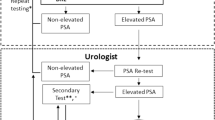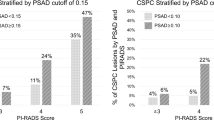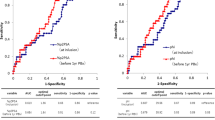Abstract
Background:
One of the major challenges in prostate cancer (PCa) treatment is distinguishing insignificant PCa from those forms that need active treatment. We evaluated the impact of PSA isoforms on risk stratification in patients with low-risk PCa as well as in active surveillance (AS) candidates who underwent radical prostatectomy.
Methods:
A total of 112 patients with biopsy confirmed Gleason score (GS) 6 PCa of four different international institutions were prospectively enrolled in the study. Blood withdrawal was performed the day before radical prostatectomy. In addition, patients were classified according to the EAU and NCCN criteria for AS candidates. PSA, free PSA (fPSA) and proPSA were measured using dual monoclonal antibody sandwich immunoassays. In addition, the Prostate Health Index (PHI=proPSA/fPSA × √PSA) was calculated. Final histology of the radical prostatectomy specimens was correlated to PSA, its isoforms and PHI.
Results:
Serum proPSA levels were significantly elevated in those patients with an upgrade in final histology (GS⩾7). In addition, higher proPSA levels were predictive for extraprostatic extension (⩾pT3a) as well as for positive surgical margins. Interestingly, PHI had an even higher predictive power when compared with proPSA alone concerning GS upgrading, extraprostatic extension and surgical margins in both the total and the AS patient group.
Conclusion:
We showed in a multicenter study that proPSA is a valuable biomarker to detect patients with aggressive PCa in a cohort of GS 6 patients, who would benefit from active tumor therapy. Combining proPSA with the standard markers PSA and fPSA using PHI further increases the predictive accuracy significantly. Moreover, our data support the use of PHI for monitoring PCa patients under AS.
This is a preview of subscription content, access via your institution
Access options
Subscribe to this journal
Receive 4 print issues and online access
$259.00 per year
only $64.75 per issue
Buy this article
- Purchase on Springer Link
- Instant access to full article PDF
Prices may be subject to local taxes which are calculated during checkout


Similar content being viewed by others
References
Stamey TA, Yang N, Hay AR, McNeal JE, Freiha FS, Redwine E . Prostate-specific antigen as a serum marker for adenocarcinoma of the prostate. N Engl J Med 1987; 317: 909–916.
Bartsch G, Horninger W, Klocker H, Pelzer A, Bektic J, Oberaigner W et al. Tyrol Prostate Cancer Demonstration Project: early detection, treatment, outcome, incidence and mortality. BJU Int 2008; 101: 809–816.
Heidegger I, Fritz J, Klocker H, Pichler R, Bektic J, Horninger W . Age-adjusted PSA levels in prostate cancer prediction: updated results of the Tyrol Prostate Cancer Early Detection Program. PLoS ONE 2015; 10: e0134134.
Mikolajczyk SD, Rittenhouse HG . Pro PSA: a more cancer specific form of prostate specific antigen for the early detection of prostate cancer. Keio J Med 2003; 52: 86–91.
Haese A, Graefen M, Huland H, Lilja H . Prostate-specific antigen and related isoforms in the diagnosis and management of prostate cancer. Curr Urol Rep 2004; 5: 231–240.
Catalona WJ, Partin AW, Finlay JA, Chan DW, Rittenhouse HG, Wolfert RL et al. Use of percentage of free prostate-specific antigen to identify men at high risk of prostate cancer when PSA levels are 2.51 to 4 ng/ml and digital rectal examination is not suspicious for prostate cancer: an alternative model. Urology 1999; 54: 220–224.
Pelzer AE, Volgger H, Bektic J, Berger AP, Rehder P, Bartsch G et al. The effect of percentage free prostate-specific antigen (PSA) level on the prostate cancer detection rate in a screening population with low PSA levels. BJU Int 2005; 96: 995–998.
Hori S, Blanchet JS, McLoughlin J . From prostate-specific antigen (PSA) to precursor PSA (proPSA) isoforms: a review of the emerging role of proPSAs in the detection and management of early prostate cancer. BJU Int 2013; 112: 717–728.
Sokoll LJ, Sanda MG, Feng Z, Kagan J, Mizrahi IA, Broyles DL et al. A prospective, multicenter, National Cancer Institute Early Detection Research Network study of [-2]proPSA: improving prostate cancer detection and correlating with cancer aggressiveness. Cancer Epidemiol Biomarkers Prev 2010; 19: 1193–1200.
Heidegger I, Klocker H, Steiner E, Skradski V, Ladurner M, Pichler R et al. [-2]proPSA is an early marker for prostate cancer aggressiveness. Prostate Cancer Prostatic Dis 2014; 17: 70–74.
Chiu PK, Lai FM, Teoh JY, Lee WM, Yee CH, Chan ES et al. Prostate Health Index and %p2PSA predict aggressive prostate cancer pathology in Chinese patients undergoing radical prostatectomy. Ann Surg Oncol 2016; 23: 2707–2714.
Loeb S, Sokoll LJ, Broyles DL, Bangma CH, van Schaik RH, Klee GG et al. Prospective multicenter evaluation of the Beckman Coulter Prostate Health Index using WHO calibration. J Urol 2013; 189: 1702–1706.
Loeb S, Catalona WJ . The Prostate Health Index: a new test for the detection of prostate cancer. Ther Adv Urol 2014; 6: 74–77.
Cantiello F, Russo GI, Ferro M, Cicione A, Cimino S, Favilla V et al. Prognostic accuracy of Prostate Health Index and urinary Prostate Cancer Antigen 3 in predicting pathologic features after radical prostatectomy. Urol Oncol 2015; 33: 163. e15–23.
Heidenreich A, Bastian PJ, Bellmunt J, Bolla M, Joniau S, van der Kwast T et al. EAU guidelines on prostate cancer. part 1: screening, diagnosis, and local treatment with curative intent-update 2013. Eur Urol 2014; 65: 124–137.
Bruinsma SM, Bangma CH, Carroll PR, Leapman MS, Rannikko A, Petrides N et al. Active surveillance for prostate cancer: a narrative review of clinical guidelines. Nat Rev Urol 2016; 13: 151–167.
Heidegger I, Skradski V, Steiner E, Klocker H, Pichler R, Pircher A et al. High risk of under-grading and -staging in prostate cancer patients eligible for active surveillance. PLoS ONE 2015; 10: e0115537.
Thompson J, Lawrentschuk N, Frydenberg M, Thompson L, Stricker P, USANZ. The role of magnetic resonance imaging in the diagnosis and management of prostate cancer. BJU Int 2013; 112 (Suppl 2): 6–20.
Huang YQ, Sun T, Zhong WD, Wu CL . Clinical performance of serum [-2]proPSA derivatives, %p2PSA and PHI, in the detection and management of prostate cancer. Am J Clin Exp Urol 2014; 2: 343–350.
Filella X, Gimenez N . Evaluation of [-2] proPSA and Prostate Health Index (phi) for the detection of prostate cancer: a systematic review and meta-analysis. Clin Chem Lab Med 2013; 51: 729–739.
Loeb S . Prostate cancer: is PSA velocity useful? Nat Rev Urol 2009; 6: 305–306.
Loeb S, Bruinsma SM, Nicholson J, Briganti A, Pickles T, Kakehi Y et al. Active surveillance for prostate cancer: a systematic review of clinicopathologic variables and biomarkers for risk stratification. Eur Urol 2015; 67: 619–626.
Junker D, Schafer G, Heidegger I, Bektic J, Ladurner M, Jaschke W et al. Multiparametric magnetic resonance imaging/transrectal ultrasound fusion targeted biopsy of the prostate: preliminary results of a prospective single-centre study. Urol Int 2015; 94: 313–318.
Tosoian JJ, Loeb S, Feng Z, Isharwal S, Landis P, Elliot DJ et al. Association of [-2]proPSA with biopsy reclassification during active surveillance for prostate cancer. J Urol 2012; 188: 1131–1136.
Schwen ZR, Tosoian JJ, Sokoll LJ, Mangold L, Humphreys E, Schaeffer EM et al. Prostate Health Index (PHI) predicts high-stage pathology in African American men. Urology 2016; 90: 136–140.
Frye TP, George AK, Kilchevsky A, Maruf M, Siddiqui MM, Kongnyuy M et al. Magnetic resonance imaging-transrectal ultrasound guided fusion biopsy to detect progression in patients with existing lesions on active surveillance for low and intermediate risk prostate cancer. J Urol 2016. pii: S0022-5347(16)31209-5. doi: 10.1016/j.juro.2016.08.109 (e-pub ahead of print).
Guo R, Cai L, Fan Y, Jin J, Zhou L, Zhang K . Magnetic resonance imaging on disease reclassification among active surveillance candidates with low-risk prostate cancer: a diagnostic meta-analysis. Prostate Cancer Prostatic Dis 2015; 18: 221–228.
Acknowledgements
We thank Dr Gabriele Dobler for technical support. The study was funded by the Tiroler Krebshilfe (Grant to IH).
Author contributions
IH was involved in planning and organizing the study, ethics, sample collection in Innsbruck, funding, manuscript and preparation of the revised manuscript. RP was involved in sample collection and preparation in Innsbruck, manuscript. AP contributed towards the ethics, sample collection and preparation in Innsbruck, manuscript, preparation of the revised manuscript. WP was involved in the laboratory analyses. ES was involved in the statistics and preparation of the revised manuscript. AP, EC and CL were involved in the sample collection in Bolzano. AL and EP was involved in the sample collection in Vienna. DD was involved in the sample collection in Belgrad. WH, HK and JB contributed towards the general idea and supervision.
Author information
Authors and Affiliations
Corresponding author
Ethics declarations
Competing interests
The authors declare no conflict of interest.
Additional information
Supplementary Information accompanies the paper on the Prostate Cancer and Prostatic Diseases website
Supplementary information
Rights and permissions
About this article
Cite this article
Heidegger, I., Klocker, H., Pichler, R. et al. ProPSA and the Prostate Health Index as predictive markers for aggressiveness in low-risk prostate cancer—results from an international multicenter study. Prostate Cancer Prostatic Dis 20, 271–275 (2017). https://doi.org/10.1038/pcan.2017.3
Received:
Revised:
Accepted:
Published:
Issue Date:
DOI: https://doi.org/10.1038/pcan.2017.3
This article is cited by
-
Is Active Surveillance Too Active?
Current Urology Reports (2023)
-
When to order genomic tests: development and external validation of a model to predict high-risk prostate cancer at the genotypic level
World Journal of Urology (2022)
-
Role of prostate health index to predict Gleason score upgrading and high-risk prostate cancer in radical prostatectomy specimens
Scientific Reports (2021)
-
Combining prostate health index and multiparametric magnetic resonance imaging in the diagnosis of clinically significant prostate cancer in an Asian population
World Journal of Urology (2020)
-
PSA screening—a matter of debate?
memo - Magazine of European Medical Oncology (2019)



